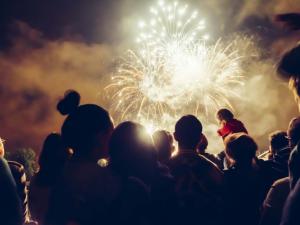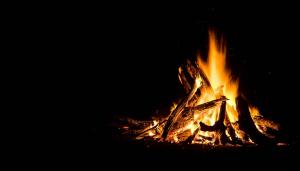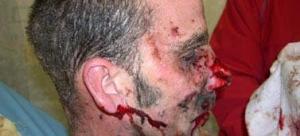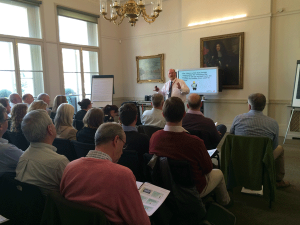It has reached that time of year again when rhyme and reason disappears in the fun of seeing explosive actions and hearing loud noises.
Sadly, although people are warned of the dangers every year, there will be somebody who thinks that he/she knows better, and there will be a serious injury from a firework display or party.
So this week, I am going to look at fireworks and firework displays in a hope that you and your family can enjoy the fun of firework night, without the need to attend A&E or call the fire brigade.
I am going to look at;
- Facts about fireworks
- Some safety tips for putting on or attending a firework display
- Share an incident where things went wrong which is compliments of the NHS Choices web site
We also have 2 recent HSE cases for you to look at and think about:
- A nurse working at Boston West Hospital, Lincolnshire, was diagnosed with occupational dermatitis on 12 January 2015, which later spread from her hands to her arms and legs.
- A clothing and textile recycling company has been prosecuted after a 76-year-old worker was fatally injured by a reversing delivery vehicle.
We hope you learn from the mistakes of others that are highlighted in our weekly newsletters and, as a result, do not have similar accidents at your workplace.
As ever, if you have a subject that you would like us to cover one week, please contact us by phone 01458 253682, email or via our Facebook page or by Twitter.
Some facts about fireworks
Fireworks are not toys. They are explosives and the injuries they can cause can be devastating. The following are facts about fireworks which may surprise you. Especially those about sparklers that parents happily light and then give to their young children!
Some safety tips for putting on or attending a firework display
Firework displays should be enjoyable and spectacular occasions – but they obviously need some responsible planning. The good news is that there is straightforward guidance to help you.
If you are organising a major public event, you will clearly need a robust and detailed approach to planning as well as professional involvement.
There are, on average, about 1,000 firework-related injuries a year. About half of these injuries occur at family or private parties.
The Royal Society for the Prevention of Accidents (RoSPA) advises that the safest place to enjoy fireworks is at a properly organised public display.
But if you’re having a celebration at home, planning ahead can reduce the risk of things going wrong.
“Good preparation is crucial for a successful and safe display,” says Sheila Merrill, RoSPA’s home safety manager for England.
Visit RoSPA’s safer fireworks website to familiarise yourself with the fireworks code, which includes safety advice to follow before, during and after your display.
Although adults tend to handle fireworks at home, half of the firework-related injuries are to children. Adults should ensure that children stay safe during firework displays.
Follow this easy checklist for a safe home firework display:
Safety tips for before a fireworks display
Things you will need on fireworks night
Safety tips for during a fireworks display
It’s illegal to set off fireworks after 11pm (except on November 5, when they can be used up to midnight, and New Year’s Eve, Chinese New Year and Diwali, when they can be used up to 1am the following day).
Safety after a fireworks display
Sparklers – safety advice
Safety around bonfires
‘A firework exploded in my face’
A giant firework exploded in Andy Minter’s face when he tried to remove the fuse from a device that had failed to go off in his garden.
He had challenged two neighbouring dads to see who could hold the biggest display in October 2007.
As the last guests left, he returned to a massive multiple firework, saved for the finale, which had not fully exploded.
“I got a bit cocky and disturbed the packaging to see if I could pull out the fuse,” says Andy, a scaffolder from Worthing in West Sussex.
As he bent down, two of the rockets shot up, hitting him in the nose and ear, and badly burning his neck.
Aware that the remaining rockets were ready to ignite in sequence, Andy quickly swerved to the side and felt the force of each one blasting off just inches from him.
“It happened instantly,” he says. “I saw sparks and then they exploded in my face. It felt as though I had run into a brick wall. I didn’t want to open my eyes, in case I lost my sight.
“Waiting for the ambulance to arrive seemed like an eternity, and the only thing in my mind was that I had lost half my face and that I was blinded for life.”
Andy’s lip was split in half and chunks of skin were taken from his cheek, nose and ear. His face was peppered with gunpowder.
He had stitches and a medical facial scrub to remove several layers of his skin to promote the regrowth of healthy tissue.
He had to have his dressings changed every couple of days for three months, and could barely open his jaw for weeks.
‘My carelessness with explosives’
Andy says his injuries were the result of carelessness and irresponsible competition between neighbours.
“Over the last few years, fireworks night had become a competition between me and two neighbours,” he says.
“The fireworks we bought had become bigger and better, and we would watch each other’s displays from our back gardens.
“Really, you need a 300ft garden to let these sorts of fireworks off, because they are so powerful.”
Andy, who was treated at East Grinstead Special Burns Unit, is fortunate enough to have almost no scars.
He says: “I had to wait six weeks before I could see how badly injured my face was. The bandages were taken off in a private room. To be honest, I was relieved. Doctors had warned me it could have been a lot worse, so I think I got off lightly.
“For ages after the accident, I didn’t want anyone to see me. I don’t know why – maybe it was the embarrassment of what had happened. I took a very long time to get over it.”
He says he shouldn’t have returned to the firework, or bought such a powerful one. “I regret going back to it and being silly,” he says. “I have flashbacks all the time.
“I was worried the accident would affect my seven-year-old son Tobi, but luckily he was in the front room when it happened and didn’t see anything.”
Enjoy the fun but please be safe.
If you would like further help on this topic or if you have any topic you would like us to cover in this newsletter please contact us by phone 01458 253682 or email.
Taunton & Somerset CPD Group at The Lawns Taunton
Martin Kent our Customer Relations Manager has arranged this month’s seminar – see below. As previously requested, if you could let Martin know whether or not you can attend it would be greatly appreciated. Also, if you would like to give a talk, or know of somebody who would, please email Martin.
Our next Seminar will now be on Wednesday 8th November not the 18th due to catering availability. Could you please arrive by 12:15pm as we will in future be starting the presentation at 12-30pm prompt.
Our speaker for this one is Dave White from Robex Industrial Products
If you haven’t already booked your place, or if you are not on the CPD Seminar mailing list but would like to be please drop Martin an email and he will deal with your request.
Just to give you some advanced notice the next seminar will be 22nd November when Savills will be coming along.
Training Courses
During November we are providing two “In House” training days for staff at the British Museum in Bloomsbury London.
As well as six training days for ABP Foods at their Abattoir/Food processing plant in Langport
You too can enjoy the benefits of superior accredited training courses as enjoyed by these companies and others.
We will soon be listing our next batch of “Open” courses which we will again be running at the Taunton Racecourse which is beautifully situated in the heart of the South Somerset countryside. The unique atmosphere and panoramic views across the racecourse to the Blackdown Hills, along with their excellent buffet lunches, make the racecourse the perfect location for successful learning.
Also remember, as shown above, we are still available for running “In House” courses and are looking to add new training courses to our list.
If you have any questions about these courses or any other training or would like us to run a particular course for you, call Jon Wilkins of the Wilkins Safety Group on 01458 253682 or email him at [email protected]
